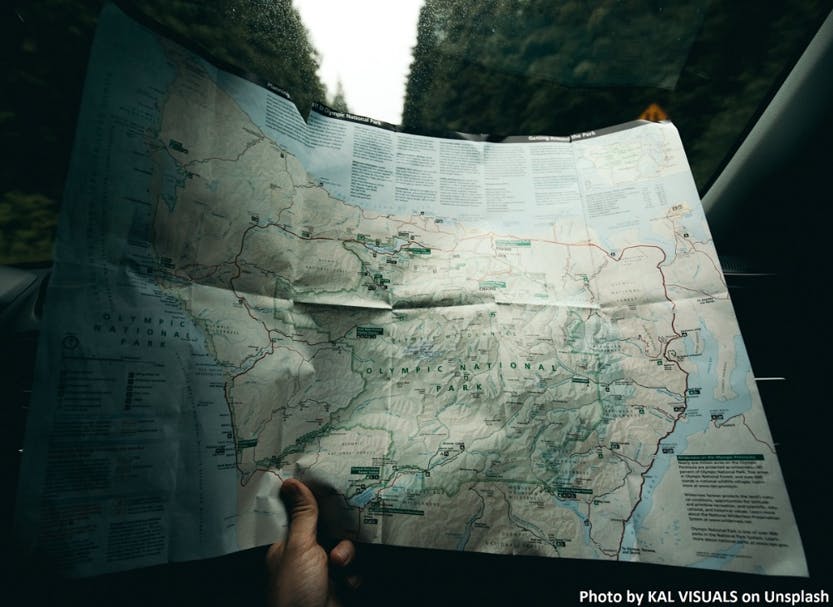Living in Seattle for the past decade I have taken advantage of our highways and byways to enjoy our state from Blaine to Vancouver, Pullman to La Push.
My favorite road trip – easily – is the loop around the Olympic Peninsula, where the weight and stress of our King County Rat Race (don’t look now, but the rats are winning!) quickly lifts from your shoulders. It’s replaced by a slower, gentler pace with many accents of nature sprinkled in from start to finish.
A typical round-trip visit can take about three days – if rushed – or more like 5-7 days if you’re looking to decompress and become one with Mother Nature. Here now are my 10 favorite places to visit (or things to do) on the peninsula.
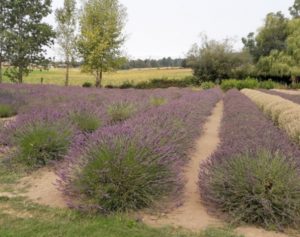
1. Sequim
Earlier, I wrote about the beautiful lavender farms in and around Sequim (pronounced SKWIM, for people new to the area). The town celebrates its claim as the lavender capital of North America with a festival every summer. Visit from spring to fall for a chance to pick a bunch of purple pleasure, and drive around the peninsula with a fragrant smell in the car and on your clothes – all the way home. Sequim, by the way, is a Klallam name for “hunting ground.”
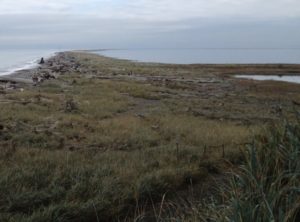
2. Dungeness Spit
One of nature’s great gifts to mankind is the various creations that make you say “Wow!”. This is one of them – a 6.8-mile stretch of sand and dirt that juts north and east from the peninsula located close to Sequim. Yes, there is a lot of walking involved – to locate the slender swath of land and to walk the full length. It is the longest natural sand spit in the U.S. Honestly, I didn’t walk the entire strip. Not enough time! (Beware: Most mobile phones use Canadian-based cell towers along the northern reaches of the peninsula and your network provider may charge extra for the “convenience” of using a U.S. phone in the U.S. while being charged for international usage.)
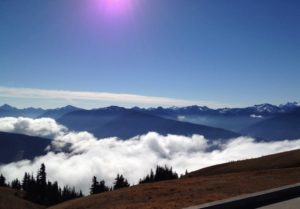
3. Hurricane Ridge
This is one of my favorite pictures from one of my favorite places on the peninsula. I timed it right – a late October day with no one around, high atop the Olympic Mountain Range at the lip of Hurricane Ridge. It was a mostly clear day, except for a few puffy clouds below the mountainous perch. Just to the right of this shot is a visitor center with everything you would need to hold you over until the next stop (open seasonally). Be careful when walking the trails above the visitor center; you may quickly find yourself facing a deer or three (like I did once!)
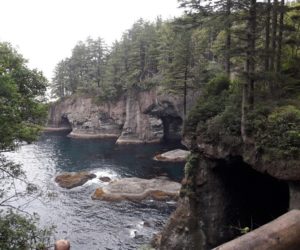
4. Cape Flattery
Cape Flattery is the northwestern-most point of the Continental U.S. Here, we are looking north from the cape where the Strait of Juan de Fuca meets the Pacific. This photo does not do it justice. There are water-filled caves with hundreds of birds nesting inside and trees standing on the precipice of the slowly eroding grounds. The cape is on land owned by the Makah Tribe and visitors of the trails are required to first purchase a recreation pass ($10 for one year) from the Makah Museum and gift shop (or other locations) around the immediate area. The terrain is a bit rugged and steep at times, so wear the right shoes to get to the very, very edge of our state.
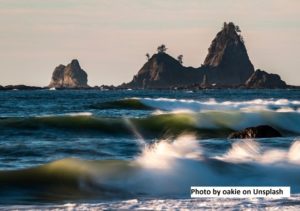
5. Rialto Beach
I hadn’t lived even a year in Seattle and people were telling me how special it was at Rialto Beach. I’ve been to many beaches – from Maine to Southern California, Gran Canaria to Mykonos – but this part of the world was unique in how rough and rugged it was, even to take steps. There is the walking from the road to the beach – a good 20 minutes – and then the climbing over and under trees before you even find it…but when you do it is as if you had discovered a secret, hideaway with mountains popping out of the water and sea life flying, swimming and crawling everywhere. After my first visit, I understood what all the talk was about. Rialto Beach is unvarnished. It’s just you and nature getting to know one another. And it is stunning for all of those reasons.
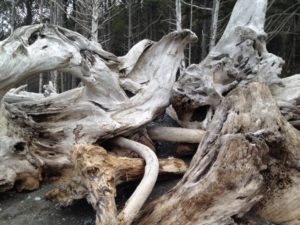
6. Second Beach
Did I tell you I like the beach? Some friends argue Third Beach is better than Second Beach. Hey, take your pick. They’re right next to each other, just south of La Push. As with Rialto, you will have to walk the trails to get to Second (or Third) Beach – but, again, it’s worth it. Mother Nature’s own art gallery – in the form of thousands of pieces of natural driftwood form a tangle of tree limbs, trunks and roots along the Washington coast, including this array of wood on Second Beach.
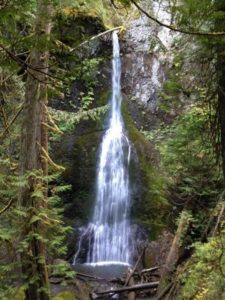
7. Olympic National Forest
While Hurricane Ridge is within Olympic National Park, the true beauty of the peninsula can be found within Olympic National Forest. The forest offers more diversity and raw beauty (IMHO). You could spend a day simply walking to rivers, streams and waterfalls (like this one). It is peaceful and serene. It is why you brought your heavy-duty clothing and shoes – and a healthy collection of nutrition and fluids to keep you energized. Using either Forks or Quinault as a base, you can explore the inner forest for a couple of days and never have a worry in your mind. (If in Forks, check out Pacific Pizza.) Or check out camping options right in the forest. (Sorry, cell phone service is virtually non-existent in the forest – or should I say, yippie!) What an escape!
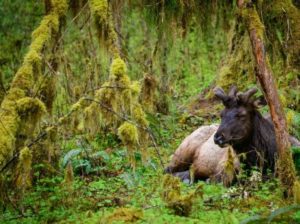
8. Hoh Rain Forest
Forks, with an average annual rainfall of 120 inches, is one of the wettest areas in the country. It’s the most-active town around and only about 30 miles from the state’s famous Hoh Rain Forest (where about 150 inches of rain fall annually…but only a handful of people live there to experience it). Our state’s rain forest is where you will see every shade of green and brown known to man – and where everything appears wet for about nine months out of the year. It’s a sponge to nature’s showers. The rain forest is within Olympic National Forest. There is a small visitor center, where the staff offer helpful ideas on trail-walking, animal-spotting (like this resting moose in Hoh) or camping locations that are open all year.
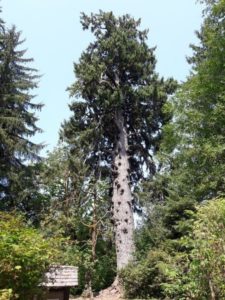
9. Tree-spotting
I will be the first to admit that I stumbled upon a few of the sites and sounds of the Olympic Peninsula without any research or planning. This is the best example. While driving around the famous Lake Quinault Lodge – I saw a road sign that simply read “World’s Record Sitka Spruce” and a well-worn trail a few feet away. I pulled the car to the side of the road and had a look. Within 5 minutes of the walk, I was standing beneath the record-setter: a Sitka Spruce that, according to a handy sign right next to the behemoth, stands 191 feet tall, 59 feet in circumference and is about a thousand years old. What a pleasant surprise. What a tree! The immediate area is also supposedly home to the world’s largest Western Red Cedar, at 174 feet tall and 63.5 feet in circumference – but I didn’t stumble upon that one during my travels.
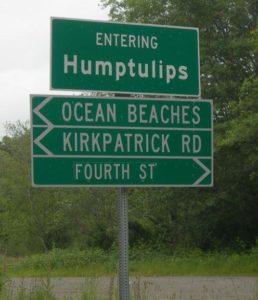
10. Just for Fun
The Olympic Peninsula comprises approximately 3,600 square miles and, outside of Alaska, is truly one of the last unexplored places in the U.S. It wasn’t until 1898 did two people – Arthur Dodwell and Theodore Rixon – begin to map the area. So, the untouched beauty can be truly appreciated. One of the quirkiest sites you will discover on the peninsula is the friendly village of Humptulips. The name means “hard to pole,” as in the difficulty tribes people had with navigating the local river with their canoes. Don’t be ashamed if you drive along US 101 right though the place, since there are only 255 people living there (according to the 2010 Census) and a handful of businesses, including a darn good grocer that will sell you everything from a loaf of bread, fishing gear to a tankful of gas.
From Humptulips there are several potential pitstops before returning home. The top options are Ocean Shores, with horseback riding on the broad sandy beaches, to Aberdeen along the mouth of the Chehalis River. You’ll find reasons to take a second trip around the peninsula but start from the south to enjoy our state from a different perspective.
Happy exploring!




